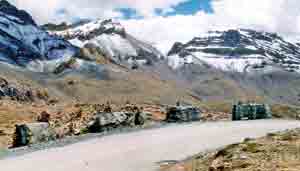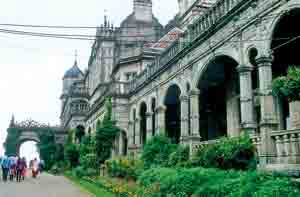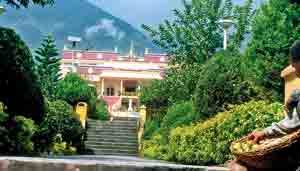Not in a hundred years of the Gods could I tell you of the glories of the Himalayas
- The Puranas
Ihave over the years had a continued fascination with the Himalayas and have viewed the abode of the Gods from Jammu and Kashmir, Nepal, Bhutan and Sikkim. In fact, when I lived in Meghalaya on a clear day one could see the Himalayan range.
My trip this time was to Himachal Pradesh and Ladakh. Since Ladakh has a high altitude, my English friend and I decided to navigate our way through the foothills of the Western region and thus get acclimatised.
 |
| Breathtaking mountain views: Driving to Ladakh |
Our first stop was the old British summer capital Shimla (another name for the Goddess Kali), now the capital of Himachal Pradesh. The plush 135-year-old Cecil Hotel where we stayed is run by the Oberoi chain and was the first hotel that was bought by Mr. Oberoi. Rudyard Kipling lived in the Tudor wing and wrote some of his books there but alas that section no longer has the original furniture.
A walk down the Mall and Ridge is a must for those interested in Gothic, Tudor and Doric buildings. A strong stick is recommended to chase away the thousands of monkeys, who inhabit the area. See the Christ Church, the second oldest church in North India with its stained glass windows; scandal point where the Maharaja of Patiala kidnapped a married English lady and ran away with her for a few days, the old Gaiety theatre where many theatrical occasions were held, and other colonial architecture, well preserved and now utilised by the Government. No vehicles are allowed on the Mall and Ridge but a drive to Cart Road and two elevators up and you are on the fringes of the Mall and Ridge. There are numerous walks to scenic areas.
We visited the famous Jakhu temple dedicated to Hanuman where the Monkey God rested on his way to the Himalayas in search of a root to revive Lakshman.
The Viceregal Lodge now the Indian Institute of Advanced Study was the scene of the original partition talks and other major decisions affecting the subcontinent during British times. This imposing residence was built in 1876 by Lord Dufferin and took four years to complete. Each brick of the six storey building was transported by mule, as the train lines had not yet been laid. Most of the furniture has been moved to the Nehru museum in Delhi, but the magnificence of the building, the gardens, the woodwork, and some furniture make it worth a visit.
Dalhousie named after Lord Dalhousie, a nine- hour drive from Shimla, is a rundown town with lovely wooded areas and views. This was used as a sanatorium because of its salubrious climate. The hotel we stayed in had architecture similar to the Bandarawela Hotel, but was not that grand. The views of the Pir Panjal range were spectacular though the early-morn invasion of monkeys into the room to share our tea and coffee was intimidating.
A great soul
Dharamsala in the Kangra valley, now the unofficial capital of the Government in Exile of Tibet was our next foray. The Dalai Lama's compound is in Mcleod Ganj, formerly a British garrison. I have always yearned to hear him, but knowing that he had just finished a three-day teaching course and was due to leave for Mexico left a gift of tea for him at his home. A Tibetan we met suggested we meet the the Karamapa who is more accessible.
So we walked around the Dalai Lama's compound, visiting his temple, seeing ancient artefacts, turning the prayer wheels (Om Mani Padme Hung) and recording on camera a devotee pausing from her prayers to answer her mobile! Modern technology has certainly seeped into prayer lives.
Prior to our visit to Gyuto monastery where the Karamapa now resides after fleeing at the age of 15 from Tibet in 2000 (a story worthy of a Hollywood movie), we visited a British church, St. John in the Wilderness where Lord Elgin, the Eighth Viceroy of India was buried (having fallen off his horse) and the Norbulingka, named after the Dalai Lama's summer residence, the Tibetan centre for reviving arts and crafts.
The Karmapa (Movement of Karma) lineage is the most ancient tulku (reincarnation of a former deceased being) lineage in Tibetan Buddhism, predating the Dalai Lama lineage by more than two centuries. The lineage is an important one as the Karmapa is traditionally the head of the Karma Kagyu School. There are three other schools of Tibetan Buddhism.
 |
| Shimla: The viceroy’s lodge |
The 17th Karmapa Ogyen Trinley Dorje Karamapa was born in a nomadic hut in the Qamdo Valley, Eastern Tibet. As a young child, he told his parents that some visitors were arriving to take him away and shortly thereafter a party of horsemen approached the family tent on their mission to find the new Karamapa. There is a controversy but the Karamapa that I met has been recognised by the Dalai Lama. He was brought up from the age of seven at Tsurphu monastery and fled to India before repressions against him by the Chinese began.
By visiting the monastery of the Karamapa prior to our audience, I was able to see the main prayer hall where over 150 monks chanted led by the Karamapa seated on his throne. The monks wore long rust coloured cloaks similar in colour to their robe. When each stanza finished the sound of cymbals echoed. The crowd of at least eighty formed four rows on the ground floor of the monastery. As the Karamapa approached I was able to see him from close. Tall and big boned, he had a regal presence. We were then led to a private room where the Karamapa handed each devotee a red thread blessed by him. I had no doubt I was in the presence of a highly reincarnated and spiritual being.
The Tibetan museum is worth a visit and it is horrific to read the stories of torture that the nuns and monks living in Tibet are subjected to, and see the photos of refugees who stream across the border.
Making the seven-hour drive to Manali, we passed tea gardens, and alpine scenery, the air turning chill as we drove higher, past Kullu, a town famous for its shawls and a type of woollen hat worn by the men of the region.
A honeymoon destination, Manali's main attractions are the Hadumba temple in the midst of a pine forest, and the Tadhan Tibetan Gompa with its beautiful frescoes and statues of Lord Padmasambhava, the Maithriya Buddha and Goddess Tara. We also visited the winter ski resort of Solang Nullah where people were para gliding, using the cable cars and enjoying the mountain vista. The sulphur hot springs in town was another attraction where there were enclosures for men and women to bathe.
High Noon on the mountain ranges
Due to the road between Manali and Leh being repaired at certain intervals, we set off from Manali at 2 a.m. on a clear night. At the Rohtang Pass, (13,054 ft) a bolt in our vehicle snapped and our chauffeur repaired it in the middle of the road. The road over the pass was non-existent. The passes are snowbound from mid-October to April and travel by road to Leh impossible thereafter.
The Saachu Pass, a tented camp, was our destination for the night. We drove past glorious high mountain ranges, awe struck by the stark beauty. Alas disaster struck as our Toyota Innova rounded a blind curve and hit a descending jeep. After the initial shock, I got down to see our driver, who had managed to get out of the vehicle lying on the side of the road bleeding. Since there was not much that one could do at such Himalayan heights, we decided to wait until some form of assistance arrived. The mobile phones were out of range! Within an hour and a half, a small bus shaped like a meat loaf with a mix of international passengers and Indians stopped.
Within minutes, my friend and I were hustled into the bus bound for Leh, and our luggage loaded on the carrier. Two Swiss German girls and an Indian boy with some knowledge of first-aid produced a first-aid bag and attended to the driver and my friend. They did not think the injuries were serious.
 |
| Gyuto monastery where the Karamapa now resides |
Introductions were made, new compatriots discovered from China, Taiwan, Switzerland and India. I was so struck with the fellowship and assistance with no thought of delays to their own journey.
A short while later as sleet fell, 50 jawans from a nearby military camp descended on us and I saw my friend being assisted out of the bus. A lorry emerged from nowhere and we again had to unload our luggage from the small bus, pile into a lorry and set off a distance of four hours in the direction we had driven that morning. We drove among awesome scenery so different from the front of the lorry and I saw the sheer drop of the passes.
Our young saviour's name was Bharkat Ali and he was returning after taking military supplies to Leh. Keylong hospital's jeans-clad doctor pronounced our injuries as not serious and after a good night's rest at a Keylong hotel arranged for us by our new friends we proceeded the next morning to Leh, Ladakh in the province of Jammu and Kashmir. The drive was thirteen hours in a jeep and our relief driver Tako was truly skilled.
Next week: Ladakh |




